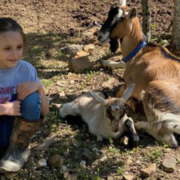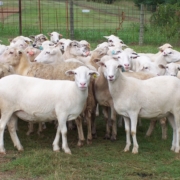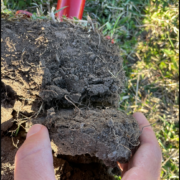Dairy Goats for the Farm
 Print This Post
Print This Post
By Linda Coffey, NCAT Livestock Specialist
This week, I will be sending a young dairy goat named Caramel to a lovely family. The seven-year-old girl who will be in charge of the goat is so excited; she and her parents have planned for shelter, pasture, and feed. They have built a new wooden milk stand. The family has visited our farm twice to get to know the goat and practice milking. I’ve trained Caramel to come in the parlor and hop on the stand. She stays still while I milk the quart or so that her kid doesn’t need, morning and night.
Caramel is sweet-natured, her milk is delicious, her kid is a female and is super cute. Her new name is Rosie Petunia. I’ve worked out a barter with the child—I’ll be getting farm-fresh eggs for the next year. This is one of the joys of raising dairy goats! I’d like to tell you about others.
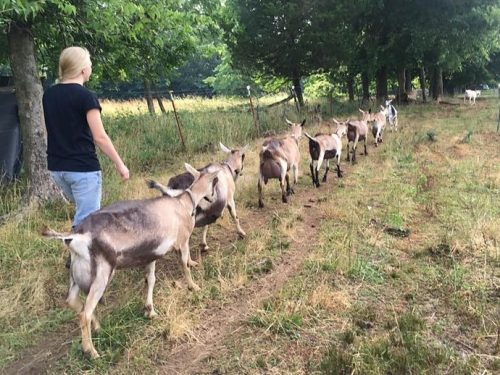
The author’s daughter heads to the barn with the milkers. Photo: Linda Coffey
Getting into Dairy Goats
My family got involved in dairy goats in a serious way in 2001, when a wonderful and wise woman mentored us as she was transitioning out of the dairy goat business. (Thank you, Janice Neighbor!) So, we benefited from many years of knowledge and good decisions about breeding. We acquired stock that were prize-winners and great producers. They were registered with the American Dairy Goat Association and well-trained to their roles on our farm. The only condition our mentor placed on us was that she wanted the goats to be shown. And so, we joined the 4-H club centered on dairy goats, transferred the papers, and prepared to learn. Here are some of the important lessons from our years with dairy goats:
- Our fencing (for sheep) was not quite adequate for dairy goats. Gates, especially, needed to be modified so that there were no gaps between gate and post.
- Goats are efficient animals, and they give a lot of milk for very little feed! A pound of grain morning and night, along with good pasture and browse, and these goats would yield a gallon or more of milk for months. Ten months is a normal lactation period.
- Dairy goats (or cows) are great for teaching responsibility and work ethic, cooperation among the family, and persistence. They must be milked twice a day, and our busy children were not always available during the evening hours. So, we all had to be ready and able to pitch in and do the milking. We all developed great forearm and hand strength, and enjoyed the time together in the barn.
- Because we had milk from several animals, we needed a way to use the milk. This led to additional enterprises: bottle calves and pigs, and economical feeding of triplet lambs. We also learned to make cheese; the whey was much enjoyed by the pigs. And, of course we had kids (baby goats) to sell.
- Dairy goats are handled more than any other animal on the farm. So, they can quickly become beloved pets. This attachment means that it is very difficult to sell a goat. Yet if you do not sell goats, you quickly will have more work than you can handle. The year we had 13 does in milk, it was very apparent that we needed to downsize the operation! As difficult as this is, an enterprise must be kept manageable.
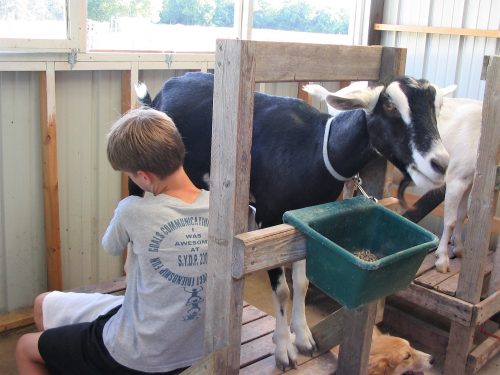
The author’s son milking. Photo: Linda Coffey.
Dairy Goats and Your Farm Goals
Every farm needs a purpose, a goal, a mission. Ours included “Raising as much of our food as possible, while raising our children to be hard-working, responsible, appreciative, and close to nature and each other.” On our farm, the dairy goats helped accomplish all of that. They enable us to raise our own beef, pork and lamb, and produce our own milk and cheese. We also sell registered kids and milking does to other families, and participate in the county fair. In addition, we participate in twice-daily chores, experience the wonder of new life, and enjoy the personalities and quirks of these productive and beautiful animals. If dairy goats might help you accomplish your farm goals, here are some considerations.
- Know why you want goats, and what you will expect from the enterprise. What scale will it be?
- If you are thinking about a commercial dairy, rather than a small farm sideline, there is a lot of research to do. See ATTRA’s Dairy Goats: Sustainable Production and contact me at lindac@ncat.org for assistance. See also Carol Delaney’s book, Starting a Commercial Dairy, and the work of Gianaclis Caldwell. Visit other farms and ask questions. And definitely check out the many valuable resources at Langston University. You will need to figure out a market, and how to comply with regulations. (I’m providing links to resources at the end of this post.)
- The breed you choose is less important than starting with healthy, quality goats. We benefited from our mentor and from a breeder with years of experience in a commercial goat dairy (thank you, Debbie Taylor!). I highly recommend that you find a mentor and learn all you can before going to look at goats for your farm. Take someone knowledgeable with you if you possibly can.
- Be sure you have the resources needed to care for your animals well. This includes time and money for the feed and especially a good forage supply, including pasture, browse, and hay. A good resource for exploring is the ATTRA publication Small Scale Livestock Production, which includes a sample budget.
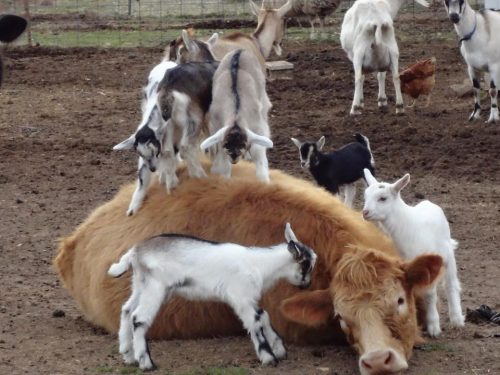
Blondie the calf seems resigned to being a jungle gym for playful kids. Photo: Linda Coffey.
Dairy goats have brought us joy and challenge, beauty and aggravation. Our farm wouldn’t be the same without them! Click here to see a short video of our goats, and email me at lindac@ncat.org if you’d like to discuss this enterprise.
Related ATTRA Resources:
Dairy Goats: Sustainable Production
Illustrated Guide to Sheep and Goat Production
Small-Scale Livestock Production
Episode 43: White River Creamery
Episode 54: Baetje Farms, Part 1
Episode 55: Baetje Farms, Part 2
Sheep and Goats: Frequently Asked Questions
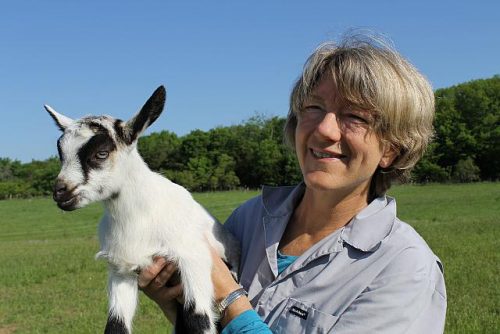
The author with one of her beautiful kids. Photo: Robyn Metzger, NCAT.
Other Resources:
Gianaclis Caldwell
Gianaclis Caldwell has been a goat producer and cheesemaker for years. She has used her practical experience and thorough research to produce excellent books that are perfect for anyone wanting to keep dairy animals. Her books are essential for anyone wanting to do a commercial artisan cheese business. The books on my shelf are: The Small Scale Dairy and The Small Scale Cheese Business, both from Chelsea Green Publishing. See Gianaclis’ website to learn more and to contact her for consulting or for teaching classes. She’s got a blog and videos, a YouTube channel, and more.
Carol Delaney
Small Ruminant Specialist Carol Delaney offers a great book, Starting a Commercial Dairy, available for free. This book will help you think through a commercial enterprise. Reading it is time well spent.
Langston University
The information offered by Langston University’s E (Kika) de la Garza American Institute of Goat Research is so important. For beginners with dairy goats, I highly recommend the colorful and easy-to-understand book, Dairy Goat Production Basics. It is full color throughout and features many drawings and charts, with blocks of text that are easy to follow. This book is a treat.
Langston University offers trustworthy, science-based information with a practical and readable handbook format. There is also an online course, a more detailed book, and a web-based ration balancing program. In addition, they offer tutorials in doing fecal egg counts, years of conference proceedings from the annual Goat Field Days, and a course for meat goat producers that is outstanding. Online materials are free; the books are worth the price. Go here to find order forms for the books and links to the online material. The certification courses for dairy and meat goats and the ration balancing are here.
The American Dairy Goat Association
This is the organization to join if you want to be breeding dairy goats. Dues are modest and registered goats may be shown at fairs, increasing the value for youth producers and adding excitement for adults, as well. There are sections of the site that are only accessible to members; however, if you are interested in a commercial dairy, ADGA offers an easy way to find out who to call in your state to learn about the regulations here. Lots of great information about dairy goats, including breeds, can be accessed here and here.

